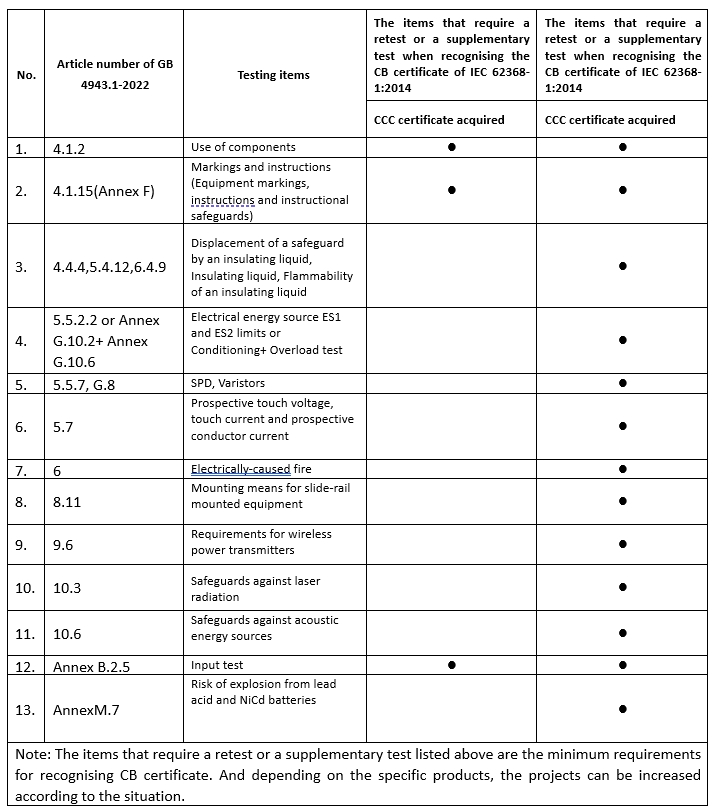



The relation between IEC 62368-1 and GB 4943.1-2022
The development of technology and the integration of audio and video products, information technology and communication technology products lead to less obvious boundaries between various products. Evaluating products according to different standards is not only difficult to operate, but also hard to adapt to the emerging new technologies and products. To solve this problem, IEC started the development of IEC 62368-1 in 2002.Then the TC 108 successively issued IEC 62368-1:2010 (version 1.0), IEC 62368-1:2014 (version 2.0), IEC 62368-1:2018 (version 3.0) in 2010, 2014 and 2018. Version 3.0 corrects the issues encountered in verification and the design costs increase in version 2.0. It also incorporates the safety requirements brought about by new technologies like those related to wireless charging. It is expected to replace IEC 60065 and IEC 60950-1 as a unified standard for evaluating products in this field. The European Union, the United States, Japan, South Korea and other countries and regions are actively carrying out the transformation of new international standards and use them as the basis for testing and certification and market access.

On July 19, 2022, China's mandatory national standard GB 4943.1-2022 Audio/Video, Information and Communication Technology Equipment—Part 1: Safety Requirements was officially released, which has officially implemented on August 1, 2023, replacing the previous standards GB 4943.1-2011, GB 8898-2011. The GB 4943.1-2022 was a modified adoption of IEC 62368-1:2018.
The difference between IEC 62368-1 and GB 4943.1-2022
After the release of GB 4943.1-2022, the TC03 technical expert group analyzed the main differences of the standard, and published the items that need to retest or perform a supplementary test when applying for CCC certificate under GB 4943.1-2022 with CB report and certificate of IEC 62368-1, as detailed in Table 1 below. It is clear that the difference between GB 4943.1-2022 and IEC 62368-1:2014 is huge, but the difference between GB 4943.1-2022 and IEC 62368-1:2018 is small, which means that only the items listed in article 4.1.2 Use of Components, Annex F Markings and Instructions, and Annex B.2.5 Input Test require a retest or a supplementary test.
Annex 3: The items that require a retest or a supplementary test when applying for CCC certificate of GB 4943.1-2022 with CB report and certificate of IEC 62368-1
When applying for GB 4943.1-2022-based CCC certificate with CB report conformed with IEC 62368-1, the CB report shall be checked, and the tests listed in the table below shall be supplemented in the lab to issue the CB verification report and the test report of the supplementary projects.
If the IEC62368-1:2014-based CB report and certificate are provided, the enterprise needs to declare that it has assessed that the remaining provisions meet the requirements of the GB 4943.1-2022.
In addition, the CB report format of IEC 62368-1:2018 published on the official website of IECEE has also published differentiated article for China.
For foreign stakeholders, that sells relevant products in China, this provides a new idea for enterprises, which means by using CB certificate and test report to complete the standard version conversion in China will have two advantages: first, reduce the test period for obtaining a new certificate under GB 4943.1-2022; secondly, certification cost will also be reduced.
Additional Information: What are IECEE and IECEE-CB systems?
The International Electrotechnical Commission System of Electrical Equipment and Components (IECEE) is an international certification organization authorized by the International Electrotechnical Commission (IEC
IECEE-CB scheme is the first truly international scheme for mutual recognition of safety test reports for electrical equipment. The implementation unit of the CB scheme is the national certification bodies (NCB) that are accepted in accordance with the CB scheme rules. After the testing laboratory is accredited as CBTL qualified laboratory, the CB report issued by it can be recognized by other member states, so that the tested products can obtain access to the countries’ market, achieving the goal of "one standard, one test, global access", and effectively reduce technical barriers to trade.


